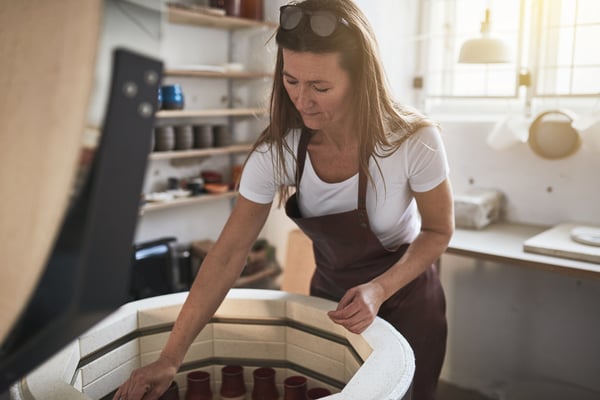
While some industries have been using motion control solutions for years, other industries could still benefit from modern hinge designs – ceramics being one of them.
A ceramic kiln lid is typically heavy and cumbersome, but with the right counterbalance hinge, kiln lids could open and close with ease, making them safer overall.
Keep reading to learn how motion control solutions can improve not just kiln lids, but other ceramic studio equipment too!
What is Motion Control Engineering?
Motion control engineering takes advantage of physics to improve the usability and safety of doors, lids, and other hinges. Many of these solutions use counterbalanced hinges – hinges that are weighted and balanced in such a way that the weight and feel for the user are purposefully altered.
If you have ever lifted the lid on a high-end grill and noticed how you could hold it open with a finger, you have used a counterbalanced hinge. The lid could be 50 pounds, but you might only feel a fraction of that weight at the handle.
Motion control does more than make heavy lids lighter, however, it can provide soft close and lid stay features too.
Motion Control for Ceramic Studio Equipment: Kiln Lids
Kiln lids need to be heavy to properly insulate and seal the kiln – but the user doesn’t necessarily need to hoist up the full weight of the lid. Counterbalancing could allow you to design kiln lids that lift easily, close at a certain speed, stay open, and so on.
To design a counterbalanced hinge for a kiln lid, it is necessary to account for at least three factors:
- Temperature: Many kilns operate at temperatures above 2,000 degrees Fahrenheit. The hinge will need to stand up to high temperatures, even if it’s on the outside of the kiln.
- Weight: Kiln lids are notoriously heavy. The hinge will have to be sturdy enough to bear heavy weight repeatedly, ideally for the life of the kiln.
- Structure: How will the hinge be attached to the kiln, and where? It depends on what type of ceramic/firebrick is used on the kiln. It may be necessary to add additional structure to attach the hinge.
The right hinge designer would pay careful attention to all of these factors and may need to do some creative problem-solving.
For instance, it might be possible to strengthen the kiln with a metal band that would go down to the base. The counterbalance could be structured to the base instead of the firebrick, preserving the integrity of the kiln interior.
What Types of Kiln Lids Use Counterbalance Hinges?
Most kilns try to use spring assist to make lids easier to open. But counterbalancing could improve on the spring assist design by making the kiln lid or pottery lid lighter through the full range of motion.
Kilns for personal use or small pottery studies are usually in the $2,000 range, so integrating a counterbalance hinge isn’t economically viable.
On the other end of the spectrum, industrial kilns can be upwards of $500,000. These kilns might not need hinges, however, because they could be open air kilns for large production lines.
To justify adding a counterbalance hinge, the kiln needs to be a happy medium between the two prices (and still have a lid!).
Motion Control for Other Ceramic Studio Equipment
Other ceramic studio equipment could benefit from motion control solutions. For instance, the big slab roller wheel on slab rollers could be made to swivel, reducing strain on the user.
Other heavy equipment like mixers could be stored more easily with a hinging system.
Storage cabinets or drying racks might have heavy doors or adjustable shelves, so motion control is applicable there as well.
A good rule of thumb: if there’s a moving part, there’s an opportunity for motion control!
Ergonomics in the Ceramic Studio
Motion control solutions and hinging systems can also improve ergonomics. For many potters, the studio is their primary working environment, so they might have an office space next to the throwing wheel.
And office ergonomics is important for any work environment. Ergonomic accessories can improve workplace health and safety, so consider:
- Monitor arms
- Adjustable lights
- Height-adjustable desks
- Computer trolleys
Improving Any Workspace With Motion Control & Ergonomics
While many of the examples here are specific for ceramic studio equipment, know that motion control engineering can benefit almost every workspace there is!
From kitchen appliances to industrial testing chambers, counterbalancing and motion control can make lifting lids easier and opening doors safer.
To learn more about the capabilities of motion control, check out our free guide! It’s a great way to get started in the world of motion control.
.png?width=12000&height=2033&name=WeberKnappLogo_white%20(1).png)


